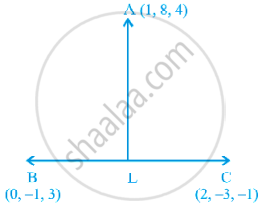Advertisements
Advertisements
प्रश्न
Find the co-ordinates of the foot of perpendicular drawn from the point A(1, 8, 4) to the line joining the points B(0, –1, 3) and C(2, –3, –1).
उत्तर
Let L be the foot of perpendicular drawn from the points A (1, 8, 4) to the line passing through B and C as shown in the Figure.
The equation of line BC by using formula `vecr = veca + lambda(vecb - veca)`, the equation of the line BC is
`vecr = (-hatj + 3hatk) + lambda(2hati - 2hatj - 4hatk)`
⇒ `xhati + yhati + xhatk = 2lambdahati - (2lambda + 1)hati + lambda(3 - 4lambda)hatk`
Comparing both sides, we get
`x = 2lambda, y = -(2lambda + 1), z = 3 - 4lambda` ......(1)
Thus, the co-ordinate of L are `(2lambda, -(2lambda + 1), (3 - 4lambda)`
So that the direction ratios of the line AL are `(1 - 2lambda), 8 + (2lambda + 1), 4 - (3 - 4lambda)`
i.e. `1 - 2lambda, 2lambda + 9, 1 + 4lambda`
Since AL is perpendicular to BC, we have
(1 – 2λ) (2 – 0) + (2λ + 9) (–3 + 1) + (4λ + 1) (–1 –3) = 0
⇒ `lambda = (-5)/6`
The required point is obtained by substituting the value of λ, in (1), which is `((-5)/3, 2/3, 19/3)`.
APPEARS IN
संबंधित प्रश्न
The x-axis and y-axis taken together determine a plane known as_______.
Coordinate planes divide the space into ______ octants.
Three vertices of a parallelogram ABCD are A (3, –1, 2), B (1, 2, –4) and C (–1, 1, 2). Find the coordinates of the fourth vertex.
If the origin is the centroid of the triangle PQR with vertices P (2a, 2, 6), Q (–4, 3b, –10) and R (8, 14, 2c), then find the values of a, b and c.
Name the octants in which the following points lie: (5, 2, 3)
Name the octants in which the following points lie:
(7, 4, –3)
Find the image of:
(–5, 4, –3) in the xz-plane.
A cube of side 5 has one vertex at the point (1, 0, –1), and the three edges from this vertex are, respectively, parallel to the negative x and y axes and positive z-axis. Find the coordinates of the other vertices of the cube.
Planes are drawn through the points (5, 0, 2) and (3, –2, 5) parallel to the coordinate planes. Find the lengths of the edges of the rectangular parallelepiped so formed.
Determine the point on z-axis which is equidistant from the points (1, 5, 7) and (5, 1, –4).
Find the points on z-axis which are at a distance \[\sqrt{21}\]from the point (1, 2, 3).
Prove that the point A(1, 3, 0), B(–5, 5, 2), C(–9, –1, 2) and D(–3, –3, 0) taken in order are the vertices of a parallelogram. Also, show that ABCD is not a rectangle.
Find the coordinates of the point which is equidistant from the four points O(0, 0, 0), A(2, 0, 0), B(0, 3, 0) and C(0, 0, 8).
Verify the following:
(0, 7, –10), (1, 6, –6) and (4, 9, –6) are vertices of an isosceles triangle.
Find the locus of the point, the sum of whose distances from the points A(4, 0, 0) and B(–4, 0, 0) is equal to 10.
Write the coordinates of the foot of the perpendicular from the point (1, 2, 3) on y-axis.
Find the ratio in which the line segment joining the points (2, 4,5) and (3, −5, 4) is divided by the yz-plane.
Let (3, 4, –1) and (–1, 2, 3) be the end points of a diameter of a sphere. Then, the radius of the sphere is equal to
XOZ-plane divides the join of (2, 3, 1) and (6, 7, 1) in the ratio
The coordinates of the foot of the perpendicular drawn from the point P(3, 4, 5) on the yz- plane are
The perpendicular distance of the point P(3, 3,4) from the x-axis is
The length of the perpendicular drawn from the point P(a, b, c) from z-axis is
Find the direction cosines of the line passing through the points P(2, 3, 5) and Q(–1, 2, 4).
Find the equation of the plane through the points (2, 1, 0), (3, –2, –2) and (3, 1, 7).
If the directions cosines of a line are k, k, k, then ______.
The sine of the angle between the straight line `(x - 2)/3 = (y - 3)/4 = (z - 4)/5` and the plane 2x – 2y + z = 5 is ______.
The cartesian equation of the plane `vecr * (hati + hatj - hatk)` is ______.
The unit vector normal to the plane x + 2y +3z – 6 = 0 is `1/sqrt(14)hati + 2/sqrt(14)hatj + 3/sqrt(14)hatk`.
The line `vecr = 2hati - 3hatj - hatk + lambda(hati - hatj + 2hatk)` lies in the plane `vecr.(3hati + hatj - hatk) + 2` = 0.
